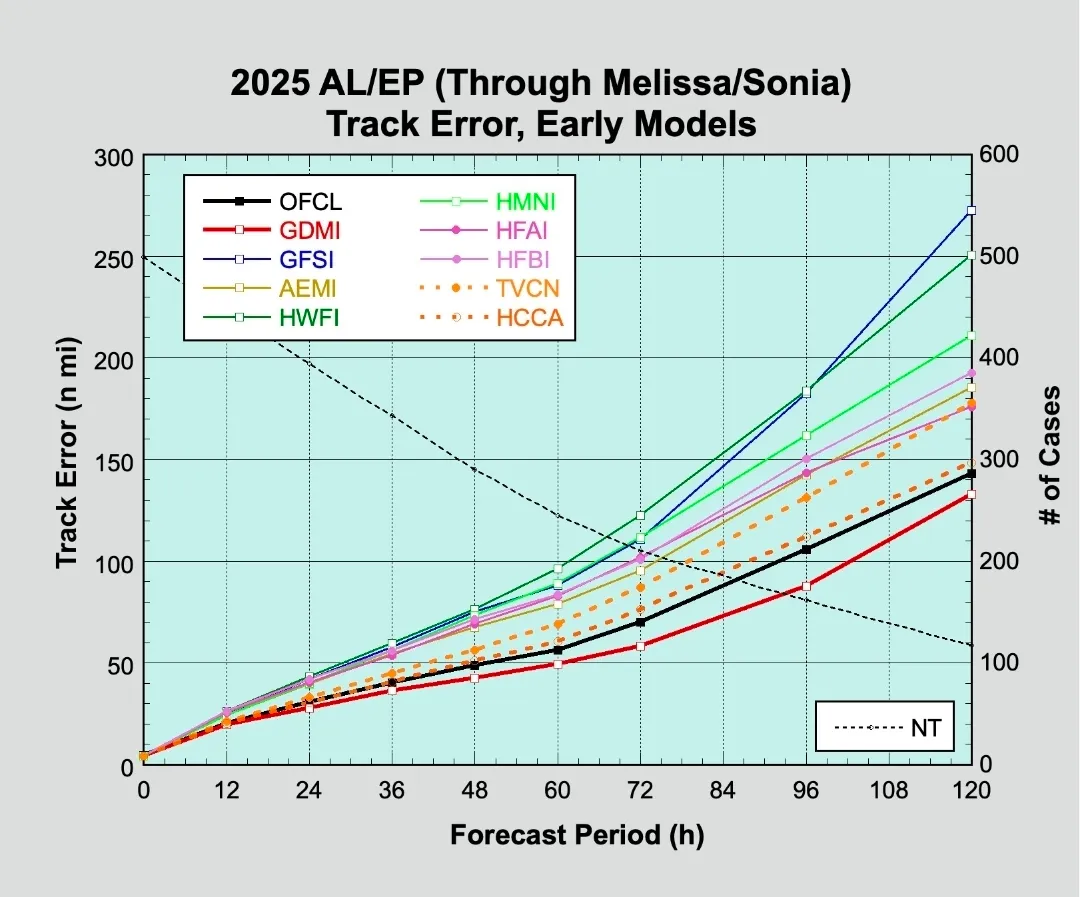JACKSONVILLE, Fla. — To become a part of the First Alert Neighborhood weather station network powered by Tempest - scan below &/or click * here *:

Updated every day throughout the hurricane season as we move through our last month of the Atlantic season - “Talking the Tropics With Mike”.
Speaking of the tropics... retired NHC forecaster James Franklin has tracked this season’s (2025) Atlantic & E. Pacific tropical cyclones & how models performed. The new Google Deep Mind (GDM) - an AI model - has come out on top along with the European model (AEMI). GDM was particularly strong once a system was identified/formed. Powerful hurricane “Melissa” was a good example though the AI model was too far east early in the “game”. The American GFS model has not been good for most of the season including popping way too many “phantom” storms. And the model was way too early to turn Melissa northeast & out to sea though it did consistently at least indicate development early on & was also on to the intensity. In the end - the GFS along with several other NOAA hurricane models had a rough season.


As we move into Nov., it’s time to think about the average date of our first freeze across Northeast Fl. & Southeast Ga. The average date of the first 32-degree temp. in Jacksonville is Dec. 8th (JIA). Remember the “average date” translates to 50% the first 32 degree temp. is before Dec. 8 & 50% of the time it’s after Dec. 8:
*Average* (that means 50% of the time) date of the first freeze for Jacksonville, Florida/NE Fl./SE Ga. @actionnewsjax @wokvnews #FirstAlertWx pic.twitter.com/puBm4C9pdY
— Mike Buresh (@MikeFirstAlert) November 4, 2025
The China Meteorological Administration (CMA) has released Fenghe, its first AI meteorological service system. Jointly developed with Tsinghua University, it is designed to promote “the intelligent transformation” of meteorological services, the CMA said. More info. * here *. A definite sign of the times!
Night skies - from Sky & Telescope:
Nov. 6 (dusk): The Moon, 1½ days past full, trails the Pleiades by 5½° as they climb in the east-northeast.
Nov. 9 (evening): The waning gibbous Moon is less than 3° to the lower right of Pollux, Gemini’s brightest star. Jupiter, in turn, is 4° lower right of the Moon.
Nov. 13 (morning): The waning crescent Moon follows Regulus in Leo by 4½° in the east.
Nov. 17 (dawn): The thin lunar crescent and Spica, in Virgo, are less than 2° apart low in the east.
Nov. 17–18 (all night): The Leonid meteor shower peaks and should provide a modest show as the Moon won’t interfere.

Nov. 29 (dusk): High in the southeast, the Moon, one day past first quarter, is 4½° upper left of Saturn.
Dec. 3 (dusk): The almost-full Moon rises with the Pleiades (use binoculars to see the stars through the Moon’s glare).
Dec. 7 (morning): The waning gibbous Moon is 4½° below Pollux and 5° right of Jupiter, forming a triangle in Gemini high in the southwest.
Dec. 9 (evening): The Moon, two days shy of last quarter, rises just ½° above Regulus, Leo’s alpha star. The gap between the pair narrows until shortly after midnight.
Dec. 13–14 (all night): The Geminid meteor shower is expected to peak. The waning crescent Moon shouldn’t interfere with viewing.
Moon Phases
Full Moon - November 5, 8:1 9 a.m. EST (Full Harvest Moon)
Last Quarter - November 12, 12:28 a.m. EST
New Moon - November 20, 1:47 a.m. EST
First Quarter - November 28, 1:59 a.m. EST










